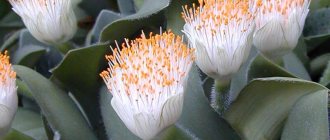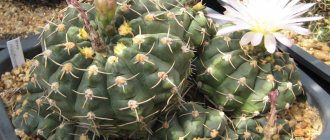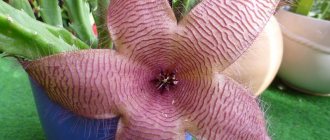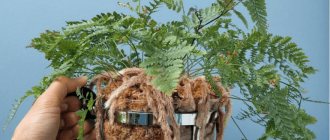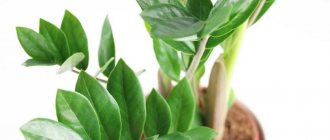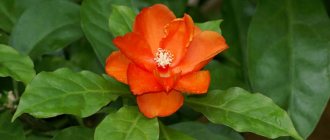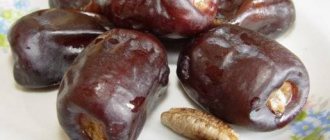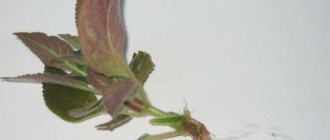The spurge cactus plant is a succulent with a triangular stem and small leaves. In its natural habitat it grows in harsh conditions, so at home it retains its decorative appearance for a long time even without proper care. To grow a succulent you need to have some experience and knowledge.
Euphorbia cactus - description
The place of origin of the plant is the island of Madagascar and the subtropics of Africa. In nature, there are more than 2 thousand species of monoecious and dioecious succulents. Under natural conditions, indoor spurge cactus reaches a height of 6-8 m. The plant has a fleshy trunk with a ribbed surface, which is all studded with small spines. Another name for the succulent is Mexican cactus.
Indoors, the plant can stretch 2-3 m, and its bright green stems begin to branch greatly. Small oblong leaves reach 2-3 cm in length. They are located at the top of the milkweed cactus. The leaves quickly fall off, but new ones grow in their place. You can often find the plant in office premises, on balconies or covered terraces.
How does the spurge cactus bloom?
Keeping a succulent at home requires some knowledge about its characteristics. For example, the plant grows quickly and reaches up to 3 m in length, forming a large number of side shoots. The bright green stems and oblong leaves have a decorative appearance. Euphorbia euphorbia cactus, under the right conditions, pleases owners for several years. When grown indoors, the succulent does not bloom, but in its natural subtropical environment it forms small white buds.
Is spurge cactus poisonous or not?
Amateur gardeners are hesitant to plant a succulent because they are afraid of its characteristics. It is believed that the spurge plant negatively affects the human nervous system and causes insomnia. In addition, the presence of milky sap with toxic properties becomes an unpleasant phenomenon for gardeners. When it gets on the surface of the skin, blisters, redness, and severe itching occur. The affected areas of the body should be immediately washed and lubricated with glucocorticoid cream. If milkweed juice is ingested, vomiting and diarrhea immediately occur. If it penetrates the eyes, it causes blindness.
However, the plant also has beneficial properties, for example, it is able to purify indoor air and destroy dangerous microorganisms. Indoor spurge cactus is used to remove warts, calluses or corns. In India, the stems are dried, crushed, and the powder is sprinkled on wounds from snake bites. When collecting poisonous sap, it is important to prevent its inhalation and contact with the surface of the skin or mucous membranes.
What they write on the forums: problem solving
Even experienced flower growers from time to time encounter the vagaries of a three-sided favorite, and even more so for beginners. Fortunately, the Internet is replete with a variety of thematic forums, on the pages of which you can share your problem and receive a comprehensive answer. Frequently encountered topics include the following:
Question from the greeninfo.ru forum:
I have a problem with a 5 year old triangular milkweed. Rotten rot and mold appeared from below. The skin of the moldy area peels off at the slightest touch. What did I do wrong? Maybe I filled it too much? It would be a shame to throw it away, the plant is tall, more than a meter. Maybe it makes sense to cut off the rotten place and plant again? Will he give you the roots? Help with advice, please!
Answered by Pavel (Ukraine):
Most likely the plant is overfed with nitrogenous fertilizers. In combination with high air humidity, this leads to the development of bacteria and rotting of the roots. At the same time, the stems and leaves do not look sick. Remove rotten areas, wash with Bordeaux mixture and transplant the spurge into a pot with fresh soil. If mold has been added to the rot, treat the plant with the antifungal drug “Quadris”. Diseased leaves should be picked and disposed of. Act as soon as possible, otherwise your plant will die.
Question from the greeninfo.ru forum:
My six-year-old milkweed is dying. The shoots rot and fall, the trunk is soft and peels off. How to deal with the disease?
Natalia Semenova (Moscow) answers:
You can save the plant by re-rooting it in small parts. Cut above the rot, carefully, without touching the affected areas. Hold under cold running water and wait until the milky juice drains from the cut. Let it dry for a couple of days. Dip the cuttings into the roots and plant them in a slightly moistened soil mixture of sand and peat. At first, water from a tray so that only the bottom layer of soil gets wet.
Question from the greeninfo.ru forum:
My milkweed grows on the windowsill, in the soil for cacti and succulents. In five years, the succulent has grown to the ceiling and drinks a lot of water. Once you switch to watering once a week, it begins to wither before your eyes. It was a discovery for me that spurge cannot be watered often. Maybe I'm spoiling him for nothing? Maybe it’s worth abstaining, torturing it with dryness so that rot doesn’t start? Here is a photo of my pet:
Natalia Semenova (Moscow) answers:
The fact is that there are general recommendations that may vary depending on specific conditions. If your succulent develops well in these conditions, you don’t need to change anything. There is a suspicion that the pot is small (it’s not very visible in the photo), but there is plenty of light. Because of this, the plant gushes water as if it were crazy. If the pot were in a large container and in the shade, watering would have to be reduced. Take care as you were taken care of.
Question from the homeflowers.ru forum:
I envy the owners of tall, bushy milkweeds with white envy. Mine grew with some kind of stick until I was advised to cut into the top. As a result, the plant stopped growing. At all. What to do?
Global moderator responds:
In fact, trigon is one of the most unpretentious plants. In our office there is this flower on almost every windowsill. That is, the areas of residence are different, but it develops equally well everywhere. It bushes without problems and easily tolerates short-term drought and poor soil. Just wait until the plant acclimatizes and gets used to it. After a while, the milkweed will certainly produce several new shoots and begin to bush.
Question from the homeflowers.ru forum:
Help me resolve this dilemma. My euphorbia chandelier has long since outgrown the meter mark. To be more precise, it grew to 1.3 meters. And I really want a lush bush. I wanted to transplant it into a darker pot, but I couldn’t find any roots. It's even strange. Maybe put the kids with him? Thanks in advance for your answers.
Types of milkweed cactus
The decorative succulent is common as a house flower in many countries. In addition, the spurge cactus can be found in forests and wild meadows. It perfectly tolerates a lack of moisture, accumulating it inside the trunks. Popular species that have attracted amateur gardeners to grow at home include:
- Euphorbia Canarian cactus
, reaching up to 12 m in height. Its stems are ribbed with small tubercles, under which the base of an oblong leaf begins. - The most popular spurge cactus is triangular
, with slightly flattened trunks. A distinctive feature of the plant is the double type of spine. - Euphorbia tirucalli cactus
, which looks like a real tree, reaching a height of 8-10 m. The branches of the plant are thick, bright green, completely without thorns. The leaves of this species have a linear shape.
Description, appearance and characteristics
Lovers of exotic plants especially note 3 main features of milkweed:
- application in medicine;
- energy feature;
- interesting appearance.
The plant belongs to the order of perennial, stem plants and is in the family of Perennials. This is why it is called triangular spurge. Habitat: Madagascar. At the moment, the cactus is distributed throughout the world, but in the wild it grows only in the subtropics of South America and Africa. Many tourists and travelers who have been there show photos of this exotic plant located on dry hills.
Euphorbia trigona
The main feature of milkweed is its appearance; it is entirely covered with thorns, and the stem has an oblong triangular shape. It is for this appearance that it got its name. On the upper edge of the bush there are small oblong lateral leaves. Despite the superficial root system, you can find some species of even domestic plants that stretch up to three meters.
Some bushes may have pink stems and crimson leaves, but finding such a flower is a great success. It is difficult to catch flowering, so the plant looks more like a cactus than with a flower.
Euphorbia cactus - home care
This succulent is called a real gift for those who are just starting out in floriculture. The homemade Euphorbia triangular cactus can survive in different conditions and tolerates long breaks in care. It can easily withstand a lack of sunlight, location near heating radiators and infrequent watering. However, if a euphorbia flower is kept in conditions that are comfortable for it, then it will develop much better. The main stages of care include:
- regular watering with settled water;
- proper feeding of succulents;
- periodic replanting into a container with loose soil;
- timely pruning of the plant;
- mandatory prevention of dangerous diseases.
For proper growth and development, the spurge cactus needs a breathable substrate, which can be purchased in specialized stores. In addition, the mixture is prepared independently by mixing river sand and peat in equal proportions. Fertilize home flowers only from spring to autumn. Special compositions for cacti are used once every 2-3 weeks strictly according to the instructions.
How to prune a spurge cactus?
Some gardeners do not want to limit the growth of the plant, so it reaches large sizes and becomes the main decoration of the interior. However, if the owner does not want his beloved home spurge cactus to reach an unimaginable height or the room parameters do not contribute to this, then the best way is to prune it in a timely manner. It helps to form a strong bush of bright green thick stems.
If a gardener doubts his skills, then you can use an interesting way to stop the growth of a milkweed cactus. A bottle cap is placed on the top of the succulent, which prevents further growth and ensures the active development of side shoots. The technology for pruning succulents is simple:
- The top of the trunk is shortened to the desired level with a sharp knife or pruning shears.
- The remaining sections are sprinkled with charcoal crushed to powder to speed up the overgrowth of the stem.
How to replant a spurge cactus?
For better growth and development of the succulent, it is important to regularly change the size of the container in which the succulent grows. So, a young domestic euphorbia flower is transplanted into a pot of larger diameter annually, and adult specimens – once every 3 years. Experts recommend replacing the top layer of soil in the container with fresh substrate every spring. For replanting, take a new pot with a larger diameter than the old one. The container itself should be stable, wide, and of medium depth.
The root system of the milkweed cactus is located on the surface, so the plant can fall. To prevent this from happening, each time after replanting, an adult succulent is strengthened with decorative stones. They are laid out around the flower at the bottom of the pot. The transplantation process is not complicated and consists of the following stages:
- release the plant from the old container;
- inspect the roots and remove dead areas;
- pour drainage onto the bottom of the pot;
- fill one third of it with loose substrate;
- place milkweed;
- cover with soil, straightening the roots;
- pour water at room temperature;
- compact the top layer of soil.
How to create ideal conditions for maintaining culture
Like any houseplant, milkweed needs the right conditions for its development. The flower must be provided with sufficient lighting, suitable soil, temperature and humidity in the room. .
Lighting and location
Euphorbia is a light-loving plant, so its development requires bright lighting. Choose a place for planting that receives maximum sunlight. In summer, it is better to move the pot to the balcony.
Required soil composition
For milkweed, loose soil that allows water to pass through is suitable. The appropriate primer can be purchased at the store or made by yourself. To do this, you will need to mix peat, sand, leaf and turf soil in equal proportions. In addition, the plant needs a drainage layer. It can be made from small pebbles or bricks.
Selection of flower pot
A clay pot is best suited for this plant. It should be deep and have holes for drainage. Select a pot with the appropriate dimensions so that the stem does not overhang it and fall. It makes sense to immediately place a strong, high pole in the pot and tie the stem to it as it grows.
See also
Description of the Novobelgian variety aster, features of planting and careRead
Temperature by season
Euphorbia is a heat-loving flower. It tolerates temperature changes quite steadily, but drafts can harm it. In the summer, milkweed should maintain a temperature of 20-25 degrees Celsius. In winter, spurge feels best at an average temperature of 14 degrees. This mode allows inflorescences to form. However, the temperature should not be lowered below plus ten degrees.
Room humidity
In terms of air humidity, spurge is quite unpretentious, but it is not a bad idea to regularly spray the leaves and stems with a shower. At the same time, do not forget to cover the soil with film during water procedures so as not to overwater the soil.
Euphorbia cactus - reproduction
Spring is considered the most favorable time for any action with the plant. Domestic triangular spurge is propagated in different ways:
- By cuttings
. The length of the lateral layers must be at least 10 cm. They are rooted in a moist substrate until roots appear. - Seeds
. This is how hybrids are propagated in laboratory conditions. For a home, this method is considered too labor-intensive. - Bush division
. In spring, the stem is cut into separate parts. An important condition is the presence of a root on each of them. After dividing, they are planted in separate containers with moist, loose soil.
Beneficial and harmful properties
Euphorbia triangular is beneficial and harmful at the same time. It is used due to its beneficial properties for the prevention and treatment of various ailments, but its milk is dangerous.
Benefit
Looking at the triangular euphorbia from the photo, you can’t say that it performs a lot of useful functions. Due to the fact that it works as a filter, it is often placed in the kitchen. The plant additionally secretes special disinfectants that destroy a large number of bacteria, including E. coli.
In a room where there are 1-2 bushes of this plant, mosquitoes, flies and other insects rarely appear. During research, it was proven that spurge absorbs some of the electromagnetic radiation from household appliances, so it is often placed near TVs, PCs, microwaves and other equipment.
Even those who are skeptical about the possible positive effect of the plant on human well-being and health note that by its appearance, it really improves mood and gives positive energy.
Use in alternative medicine
Among lovers of alternative medicine, the plant was often used as a remedy. In ancient India, its root was ground into a powder and used as a medicine for snake bites. Among other things, the collected juice was used to relieve pain and as a diuretic. It has also been added to treat a wide variety of other ailments:
- diseases of the female genital organs;
- skin diseases;
- upper respiratory tract diseases;
- hemorrhoids and difficulty with bowel movements;
- neoplasms;
- gastrointestinal diseases;
- diseases of the genitourinary system.
Important! Self-medication is excluded. Before taking potions or medications based on this plant, you must first consult a doctor.
Harm
Is triangular milkweed deadly poisonous or not, and how dangerous is its effect on the skin? Its poisonous juice is extremely harmful and can lead to death, so you need to be as careful as possible and take basic precautions when interacting with the flower.
Juice that gets on the skin can cause severe burn reactions, and if it splashes into the eyes, the burns can lead to loss of consciousness. Moreover, milkweed can spray from the fleshy stem even with slight pressure, so it is best to wear not only rubber gloves, but also glasses. As soon as the maintenance work is completed, you should wash your hands thoroughly.
In case of poisoning, if emergency medical care is not provided, diarrhea can quickly turn into loss of consciousness, acute heart failure and death. Therefore, if milk gets on the skin, mucous membranes or stomach, you should cleanse the body as quickly as possible and consult a doctor. It is important to place the cactus pot in places where children, cats, dogs and other pets cannot reach it.
Diseases of the milkweed flower
A strong plant is rarely attacked by pests. This is explained by the fact that juice with poisonous properties is an excellent remedy in the fight against them. However, the euphorbia cactus can be disturbed by some pests:
- aphids;
- red spider mite;
- mealybug.
A home flower does not require complex care, but its absence leads to:
- shedding of leaves from excessive watering;
- yellowing due to a large amount of fertilizer or lack thereof;
- the appearance of brown spots when exposed to direct sunlight.
Problems of growing an African flower
Since the plant is unpretentious in terms of care, there are quite few problems with its cultivation. However, there are some negative aspects that a gardener may encounter. Brown spots of rot may appear on the stem and leaves of the plant - this is a reaction to excessive watering. Due to insufficient light, milkweed stems can stretch, this is especially noticeable in winter. In addition, in a pot that is too spacious, the plant grows quite quickly due to enlarged roots.
Euphorbia cactus in the interior
The home flower euphorbia has an unusual and very decorative appearance. Not everyone is scared off by its poisonous juice; the spurge cactus can also bring benefits to the owner of a house or apartment. The succulent purifies the air in the room and kills harmful microorganisms. The cactus plant is a tall spurge, so it is best to keep it in non-residential areas. Succulents can often be found in offices. Simple care of euphorbia also affects the popularity of the flower.
You should not place it in the bedroom, because the subtle aroma of the plant leads to sleep disturbances and insomnia. The succulent looks good in arrangements with other potted flowers that have the same stem color as milkweed. It goes well with scarlet and Kalanchoe. Decorative pots emphasize the ascetic beauty of the plant, making it a real decoration of the room.
Options for using milkweed in the interior:
- Large specimens can be installed in any room alone or in groups.
- Cacti are appropriate both for floor placement and on tables, cabinets, and stands.
- Bright green spurge looks organic on both dark and light backgrounds.
Variety of Euphorbia triangularis
This species cannot boast of a variety of varieties; there is only one and we will briefly describe its features.
Euphorbia trigona 'rubra'
This variety features purple-red leaves against green stems, giving it a beautiful two-tone appearance.
Rubra is popular among gardeners who want to add bright and unique colors to their homes. Otherwise, this variety is no different from the parent species.
There is also a rather rare variegated variety called Europhobia.
Pests
Thanks to its poisonous sap, the triangular succulent rarely attracts pests.
Sometimes the succulent may attack:
- aphids (small insects located on the underside of the leaf);
- red spider mite (weaves thin threads of web);
- mealybug (leaves behind a sticky residue).
When uninvited “guests” appear, it is necessary to use insecticides or use folk remedies.
An exotic southern plant - Euphorbia triangular - is absolutely unpretentious in care. By carrying out basic activities, the gardener can easily achieve the active growth of his pet.
Conditions for growing at home
Euphorbia trigone will not require much attention from the grower if you initially provide it with comfortable conditions.
Lighting
Euphorbia loves bright light and is not afraid of direct sunlight. But you need to get used to the sun gradually so as not to provoke burns. For uniform growth of shoots, the pot is turned to the light source in different directions.
Ventilation
The plant loves fresh air; in the warm season it is taken out to the balcony or open terrace. Musty air or close proximity to heating devices will negatively affect the growth of the succulent.
We recommend that you familiarize yourself with other succulents:
Temperature
The optimal temperature in the warm season is +23...+25 °C; in the winter season lower temperatures are recommended: +16...+18 °C.
Air humidity
The plant is drought-resistant, but responds well to warm showers and spraying. During shower procedures, you need to cover the soil lump and spray it with a fine-hole spray bottle. In winter, instead of water procedures, a brush with soft bristles is used to remove dust from foliage.
How to propagate milkweed
Euphorbia triangular is propagated vegetatively; the main question is how to root the seedling and achieve healthy development.
Side shoots
The time for the procedure is spring. Side shoots are taken from a well-grown bush.
Sequencing:
- The donor plant is dumped out of the pot, carefully separating the lateral shoots with part of the roots.
- Cut seedlings are sprinkled with crushed coal and left for 2–3 hours to dry.
- Planted in a substrate and placed for rooting at a temperature of +18...+20 °C.
- Further care as for an adult plant.
Cuttings
This method is used in spring and summer. Planting material is cut apical or lateral shoots.
Rooting technology:
- The cuttings are washed from the milky liquid.
- Dry for 2–3 days.
- The sections are sprinkled with crushed activated carbon.
- Planted in damp river sand, placed in a warm place (+ 22…+25 °C).
- As soon as the cutting takes root, it will begin to grow. At this time, it is transplanted into a separate container in the ground.
Care
The main criterion for healthy growth is a well-lit place. It is also worth paying attention to watering; it should be moderate in summer and meager in winter. Do not overwater Euphorbia triangularis. When the soil becomes waterlogged or water stagnates, it begins to rot from the middle and after a while the entire plant dies.
Euphorbia trigona is undemanding to air humidity and grows well in dry climates, but in the summer you can give this plant a shower once a month.
